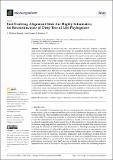Fast-Evolving Alignment Sites Are Highly Informative for Reconstructions of Deep Tree of Life Phylogenies
Author(s)
Rangel, L. Thibério; Fournier, Gregory P.
Downloadmicroorganisms-11-02499-v3.pdf (3.256Mb)
Publisher with Creative Commons License
Publisher with Creative Commons License
Creative Commons Attribution
Terms of use
Metadata
Show full item recordAbstract
The trimming of fast-evolving sites, often known as “slow–fast” analysis, is broadly used in microbial phylogenetic reconstruction under the assumption that fast-evolving sites do not retain an accurate phylogenetic signal due to substitution saturation. Therefore, removing sites that have experienced multiple substitutions would improve the signal-to-noise ratio in phylogenetic analyses, with the remaining slower-evolving sites preserving a more reliable record of evolutionary relationships. Here, we show that, contrary to this assumption, even the fastest-evolving sites present in the conserved proteins often used in Tree of Life studies contain reliable and valuable phylogenetic information, and that the trimming of such sites can negatively impact the accuracy of phylogenetic reconstruction. Simulated alignments modeled after ribosomal protein datasets used in Tree of Life studies consistently show that slow-evolving sites are less likely to recover true bipartitions than even the fastest-evolving sites. Furthermore, site-specific substitution rates are positively correlated with the frequency of accurately recovered short-branched bipartitions, as slowly evolving sites are less likely to have experienced substitutions along these intervals. Using published Tree of Life sequence alignment datasets, we also show that both slow- and fast-evolving sites contain similarly inconsistent phylogenetic signals, and that, for fast-evolving sites, this inconsistency can be attributed to poor alignment quality. Furthermore, trimming fast sites, slow sites, or both is shown to have a substantial impact on phylogenetic reconstruction across multiple evolutionary models. This is perhaps most evident in the resulting placements of the Eukarya and Asgardarchaeota groups, which are especially sensitive to the implementation of different trimming schemes.
Date issued
2023-10-05Department
Massachusetts Institute of Technology. Department of Earth, Atmospheric, and Planetary SciencesPublisher
Multidisciplinary Digital Publishing Institute
Citation
Microorganisms 11 (10): 2499 (2023)
Version: Final published version